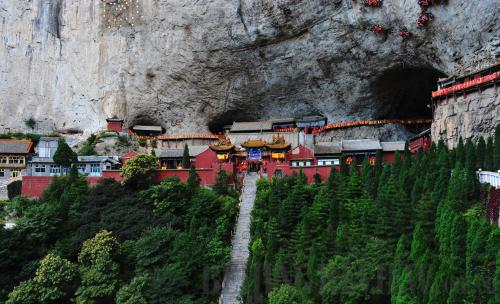|
 |
|
SERENE SCENERY: Yunfeng Temple is located in a naturally formed cave (SHI GANG) |
Mianshan Mountain is a famous cultural and historical site in the city of Jiexiu in north China's Shanxi Province. As part of a mountain range that extends over 50 km in length. The mountain, which reaches a height of 2,571 meters above sea level, has held great religious and cultural significance over the last 2,600 years. The influence of different religions has resulted in a highly unique and spiritual environment.
Unlike any other
Along the 295-square-km mountain range, some of the steeper cliffs within the valley sit at nearly a 90-degree angle. Thus, the buildings on Mianshan were never really constructed, but built into the huge caves along the edges of its cliffs.
"It shows the infinite power of nature that such a wonder has been created," Ma Zhizheng, a professor with Shanxi Normal University, said. Formed of granite, limestone and sandstone, Mianshan is located on a geological fault zone. It took shape from the shifting of Pacific tectonic plates over billions of years, while water and wind eroded the mountain's south slope, resulting in the enormous natural caves seen there today.
Yunfeng Temple, built about 1,500 years ago, is located in such a cave. The temple, along a steep cliff side, not only contains over 200 rooms but also has its own water supply, with several natural springs running through.
"The special topographic structure of the mountain has created a unique microclimate for warm winters and cool summers," said Ma. Mianshan is 90 percent covered by forest, with a mean annual precipitation of over 65 centimeters.
"Mianshan is a mountain with deep cultural and historical significance. It was first mentioned in China's earliest historical records more than 2,000 years ago," said Meng Manxi, a local cultural scholar. He noted with pride that the first Buddhist temple on Mianshan was established in the second century A.D., only around 100 years after the first Buddhist temple in all of China was constructed. In addition to its many Buddhist structures, Mianshan is a place that has concentrated temples from several other religions; there are 88 temples spread over the mountain.
However, Mianshan is known, first and foremost, as a Buddhist site. It is one of the founding areas of the Pure Land Buddhism, as Tanluan, a master of this sect, lived on Mianshan for some time about 1,500 years ago. Buddhist monks also believe that the mountain is a propitious place to become immortal through religious practice.
"Mianshan is the perfect place for hermits like monks and Taoist priests," said Guo Na, a tour guide there. She explained that the huge natural caves on the mountainside facing the south can protect people from bad weather, the proliferation of edible wild fruits and herbs can keep them fed and they can drink from the mountain's natural mineral water springs. Guo believes that these Taoists and Buddhists are able to expel toxins out of their bodies more easily, as they maintain natural organic diets, breathe clean air and religiously restrict their intake of grains.
According to Mianshan's records, 17 Buddhist monks were turned into natural mummies there, after passing away while sitting in a cross-legged meditative pose. Their bodies were painted with clay and converted into sculptures, enshrined in the mountain's Zhengguo Temple, where today, they are worshiped as immortals.
For similar reasons, Taoist priests have also considered Mianshan an ideal dwelling place. Ancient priests even formed their own special set of therapeutic health guidelines some 2,600 years ago to follow in accordance with the four different seasons. All the guidelines and temple records are stored in a library in Dailuo Palace, a grand Taoist temple on the mountain. Additionally, Confucians regard Mianshan as a place that epitomizes the traditional essence of Confucianism by promoting ideals such as loyalty and good faith.
A monumental restoration
With its strong cultural heritage and historical atmosphere as well as its beautiful scenery, Mianshan was approved as a 5A-level tourist site, the highest possible rating, by the National Tourism Administration in 2013.
|
